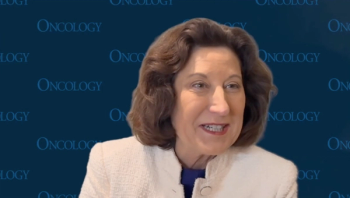
Bexobrutideg Achieves High Objective Response Rate in Heavily Pretreated R/R CLL
Bexobrutideg, a novel BTK degrader, demonstrated preliminary clinical activity and a consistent safety profile in patients with relapsed/refractory chronic lymphocytic leukemia.
Bexobrutideg (NX-5948), a novel BTK degrader, was generally well tolerated and demonstrated early efficacy in patients with relapsed/refractory chronic lymphocytic leukemia (CLL), according to updated data from the phase 1 NX-5948-301 trial (NCT05131022) shared at the
At the data cutoff date of March 12, 2025, bexobrutideg demonstrated preliminary clinical activity in a population of heavily pretreated patients with advanced CLL. At a median follow-up of 9.0 months (range, 1.6-26.1), the objective response rate (ORR) in response-evaluable patients with CLL (n = 47) was 80.9% (95% CI, 66.7%-90.9%), comprising 1 complete response (CR) and 37 partial responses (PR). Seven patients achieved stable disease (SD) and 2 experienced disease progression.
Of note, clinical activity was observed in patients regardless of TP53 or PLCG2 mutation status, covalent BTK inhibitor or noncovalent BTK inhibitor resistance mutations, or central nervous system (CNS) involvement. Moreover, responses were durable regardless of previous treatment modalities.
Bexobrutideg was well tolerated across all dose levels. Any grade treatment-emergent adverse effects (TEAEs) occurring in at least 10% of patients (n = 48) included purpura/contusion (45.8%), diarrhea (31.3%), fatigue (31.3%), neutropenia (29.2%), rash (27.1%), petechiae (25.0%), headache (25.0%), thrombocytopenia (22.9%), anemia (18.8%), COVID-19 (18.8%), peripheral edema (18.8%), cough (16.7%), lower respiratory tract infection (14.6%), nausea (14.6%), pneumonia (12.5%), arthralgia (12.5%), upper respiratory tract infection (10.4%), vomiting (10.4%), and respiratory syncytial virus infection (4.2%).
“Bexobrutideg is a novel small molecule that degrades a well-validated CLL target, BTK, by utilizing the ubiquitin-proteasome pathway,” lead study author Zulfa Omer, MD, MBBS, and coauthors wrote in a poster presentation. “There was 1 TEAE resulting in drug discontinuation, no dose-limiting toxicities, and no new onset [of] atrial fibrillation/flutter.”
Omer is an assistant professor in the Department of Internal Medicine in the Division of Hematology & Oncology at the University of Cincinnati in Ohio.
NX-5948-301 Study Design
The phase 1a study evaluated the safety and tolerability of bexobrutideg for the treatment of patients with relapsed/refractory B-cell malignancies, including CLL and non-Hodgkin lymphoma. Patients were required to be at least 18 years of age, have previously received at least 2 prior lines of therapy, and have an ECOG performance status of 0 or 1. Additionally, the study was designed with parallel 3 + 3 dose-escalation and dose-expansion cohorts.
In the fully enrolled dose-escalation portion of the study, patients with CLL or small lymphocytic leukemia (SLL) were treated with once daily bexobrutideg across 6 dose levels, including 50 mg (n = 3), 100 mg (n = 5), 200 mg (n = 9), 300 mg (n = 8), 450 mg (n = 7), and 600 mg (n = 16). In the fully enrolled phase 1b dose expansion portion, patients with CLL/SLL who received prior BTK and BCL2 inhibitors were either treated with bexobrutideg at 200 mg or 600 mg once daily.
The study’s primary end point was safety, tolerability, and identification of the recommended phase 2 dose. Secondary end points included the characterization of the pharmacokinetic and pharmacodynamic profile and assessment of preliminary efficacy, per the International Workshop on CLL (iwCLL).
Baseline Patient Characteristics
In the phase 1a portion of the study, the median age of patients with CLL/SLL (n = 48) was 68.5 years (range, 35-88), and the majority were male (66.7%). Most patients were White (87.5%), and 6.3% identified as Hispanic or Latino. Moreover, ECOG performance statuses included 0 (39.6%) or 1 (60.4%). CNS involvement was observed in 10.4% of patients.
The median number of prior lines of therapy was 4 (range, 2-12). Patients were previously exposed to covalent BTK inhibitors (97.9%), noncovalent BTK inhibitors (27.1%), BCL2 inhibitors (83.3%), BTK and BCL2 inhibitors (81.3%), CAR T-cell therapy (6.3%), bispecific antibody (6.3%), PI3K inhibitor (29.2%), and chemotherapy or chemoimmunotherapies (72.9%). Mutations in BTK (38.3%), TP53 (44.7%), PLCγ2 (14.9%), and BCL2 (12.8%) were among 47 patients with available data.
Additional Preliminary Efficacy and Safety Data
Of the 48 patients treated with bexobrutideg at 1 of 6 dose levels, 32 remained on treatment at the time of data cutoff. However, 16 patients discontinued treatment due to radiographic progression (n = 7), clinical progression (n = 3), death (n = 2), AEs (n = 1), physician’s decision (n = 1), prohibited medication/procedure (n = 1), and withdrawal of patient consent (n = 1).
Notably, 18 patients had a duration of treatment lasting more than 12 months, and 21 underwent dose escalation during treatment. The median time to first response was 1.9 months (range, 1.6-11.1), and the median duration of response was not reached (NR; 95% CI, 10.6-NR).
“Robust and deepening responses were observed [with bexobrutideg]. Responses were rapid, with a median time to first response of 1.87 months,” the study authors wrote in the poster. “Multiple conversions were observed from SD to PR, [along with] 1 conversion from a PR to CR. Of 18 patients treated for more than 12 months, 17 remain on the study, [and] 1 patient is approaching 2.5 years on treatment.”
Regarding safety, the most common grade 3 or higher TEAEs occurring in at least 10% of patients included diarrhea (4.2%), neutropenia (22.9%), anemia (4.2%), rash (2.1%), pneumonia (4.2%), thrombocytopenia (2.1%), lower respiratory tract infection (2.1%), vomiting (2.1%), and respiratory syncytial virus infection (2.1%). Serious AEs included respiratory syncytial virus infection (4.2%), pneumonia (4.2%), rash (2.1%), and lower respiratory tract infection (2.1%).
Enrollment onto additional subpopulation cohorts in phase 1b is ongoing, and pivotal trial initiation is expected later in 2025.
Reference
Omer Z, Danilov A, Forconi F, et al. Bexobrutideg (NX-5948), a novel bruton’s tyrosine kinase (BTK) degrader, demonstrated rapid and durable clinical responses in relapsed/refractory CLL: updated findings from an ongoing phase 1a study. Presented at: European Hematology Association Congress; June 12-15, 2025; Milan, Italy. Abstract PF571
Newsletter
Stay up to date on recent advances in the multidisciplinary approach to cancer.

















































































